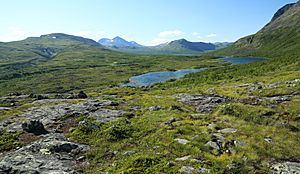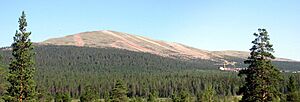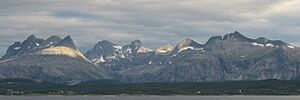Fell facts for kids
A fell is a type of high, open landscape. It often looks like a mountain range or hills covered in moorland. The word "fell" comes from the Old Norse word for "mountain." You'll hear this term mostly in places like Scandinavia, the Isle of Man, northern England, and Scotland. These areas often have cool, windy weather and not many trees on the highest parts.
Contents
What Does the Word "Fell" Mean?
The English word "fell" comes from fell or fjall in Old Norse. This is the same root word as fjall in Icelandic. It's also related to fjäll in Swedish and fjell in Norwegian. All these words describe mountains that rise above the tree line, where it's too cold for trees to grow.
Fells in the British Isles
In Northern England, especially in the Lake District and the Pennines, a "fell" originally meant high, wild land. This land was often used by local farmers to let their animals graze. Today, "fell" usually refers to the mountains and hills in these areas.
Sometimes, the name of a grazing area became the name of a hilltop. For example, Seathwaite Fell was once the grazing land for farmers from Seathwaite. A "fellgate" is a gate or path that leads from a village onto the fell.
The word "fell" is also used for certain types of livestock. These animals are specially bred to live in the uplands. Examples include Rough Fell sheep, Fell Terrier dogs, and Fell ponies.
You'll find "fell" in many place names across northern England. An example is the township of Cartmel Fell. There's even an old title called the Lord of the Fells in the Lords of Bowland area.
Many fells have groups of cairns, which are piles of stones. These often mark the top of the fell. You can see great examples on Wild Boar Fell in Cumbria and Nine Standards Rigg near Kirkby Stephen.
The Lake District is famous for the sport of fell running. This sport involves running over the fells. People in the area also use "fellwalking" to describe what others call hillwalking.
The word "fell" is sometimes used in Scotland too. Examples include the Campsie Fells near Glasgow and Goat Fell, the highest point on the Isle of Arran.
Fells in Fennoscandia
Fjell in Norway
In Norway, fjell usually means a mountain that is higher than a hill. What counts as a fjell can change from one area to another. There isn't one strict rule for it. The word fjell is the most common word for "mountain" in Norwegian.
Fjäll in Sweden
In Sweden, fjäll refers to any mountain or high land where trees cannot naturally grow at the top. This means it's like a mountain tundra. The term fjäll is mainly used for mountains in the Nordic countries. It also describes mountains that were shaped by huge ice sheets, especially in very cold, northern regions.
Tunturi in Finland
In Finland, the special mountains found in Finnish Lapland are called tunturi. These are old, rounded mountains that have been worn down over time. They don't have glaciers like some younger, jagged mountains. Tunturi also describes treeless plains in high, northern areas.
The mountains in Finnish Lapland can be between 400 and 800 meters high. Their upper parts are above the tree line. If a mountain doesn't reach the tree line, it's usually called a vaara. The tunturi mountains are what's left of the ancient Karelides mountains, which formed two billion years ago. The word tunturi comes from the Sami word for "uplands" or "treeless mountain tract." This Sami word is also where the English word tundra comes from.
Images for kids
See also
 In Spanish: Estiva para niños
In Spanish: Estiva para niños







